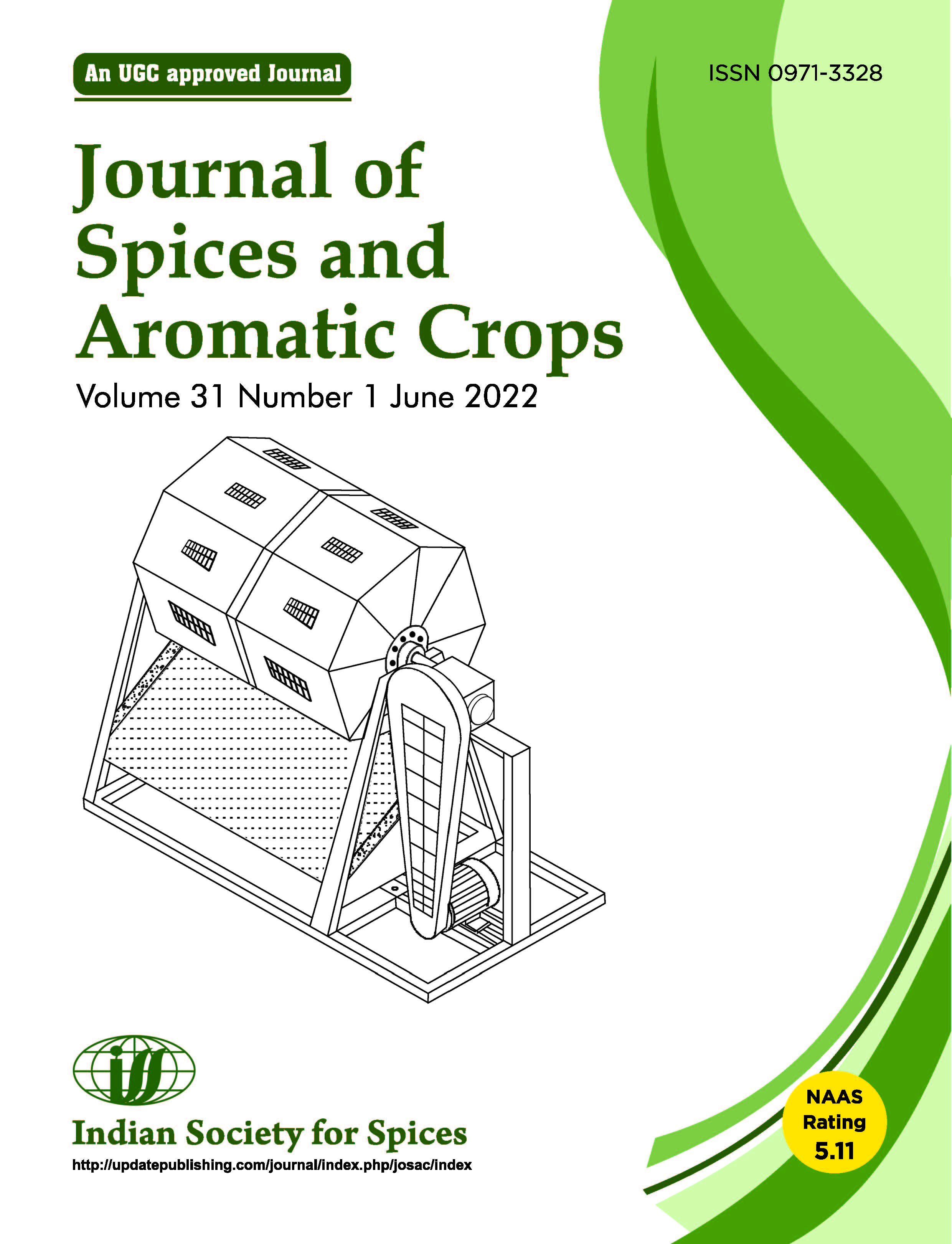Nutmeg with yellow arils-potential tree spice with high essential oil content
Nutmeg with yellow arils
DOI:
https://doi.org/10.25081/josac.2022.v31.i1.7526Keywords:
elemicin, essential oil, sabinene, yellow mace, α-pineneAbstract
The mace derived from the arils of Myristica fragrans, is red in colour, whereas the present study reports the evaluation of Myristica fragrans with yellow arils. Morphological features of fruits of M. fragrans with yellow arils and that of common red aril variant from cultivated locations in Kerala, South India, were similar. The average mace yield was higher for the yellow arils (2.5 kg plant-1) than the red arils (2.0 kg plant-1). The volatile chemical profiling revealed that the essential oil yield of the yellow mace (19.3% v/w) was more than twofold higher than standard red mace (9.2% v/w). GC-MS analysis showed that the distribution of monoterpenoids, sesquiterpenoids, and phenylpropanoids were similar in both the varieties, except for the percentage distribution. The major constituents of mace of both the red and yellow types were α-pinene, and sabinene followed by elemicin and safrole. Though an exotic species, M. fragrans has been naturalized in south India, and several high-yielding varieties have been reported from the region. The present study highlights nutmeg with yellow arils as a potential spice crop with high oil yield.
Downloads
References
Adams R P 2007 Identification of essential oil components by gas chromatography/mass spectrometry Carol Stream, IL: Allured Publishing Corporation.
Akinboro A, Mohamed K B, Asmawi M Z & Yekeen T A 2014 Antimutagenic effects of aqueous fraction of Myristica fragrans (Houtt.) leaves on Salmonella typhimurium and Mus musculus Acta Biochim. Pol 61(4): 1-7.
Asgarpanah J & Kazemivash N 2012 Phytochemistry and pharmacologic properties of Myristica fragrans Houtt: A review Afr. J. Biotechnol 11(65): 12787–12793.
Chauhan N S, Sharma V, Dixit V K & Thakur M 2014 A review on plants used for improvement of sexual performance and virility Biomed Res. Int. 1-19.
Choo L C, Wong S M & Liew K Y 1999 Essential oil of nutmeg pericarp. J. Sci. Food Agric. 79 (13): 1954–1957.
Ehlers D, Kirchhoff J, Gerard D & Quirin K W 1998 High‐performance liquid chromatography analysis of nutmeg and mace oils produced by supercritical CO2 extraction–comparison with steam‐distilled oils–comparison of East Indian, West Indian and Papuan oils. Int. J. Food Sci. Technol. 33(3): 215–223.
Jukić M, Politeo O & Miloš M 2006 Chemical composition and antioxidant effect of free volatile aglycones from nutmeg (Myristica fragrans Houtt.) compared to its essential oil. Croat. Chem. Acta. 79(2): 209–214.
Kumar R S, Krishnamoorthy B, Prasath D, Venugopal M N, Ankegowda S J & Biju C N 2010 Variability in Nutmeg (Myristica fragrans Houtt.) under high rainfall and high altitude Kodagu region of Karnataka Indian J. Genet. Plant Breed 23(2): 191–194.
Leela N K 2008 Nutmeg and Mace Chemistry of spices. 165–189.
Mallavarapu G R & Ramesh S 1998 Composition of essential oils of nutmeg and mace. J. Med. Arom. Pl. Sci. 20: 746–748.
Maya K M 2004 Chemical composition of essential oil of nutmeg (Myristica fragrans Houtt.) J. Spices Arom. Crops 13(2): 135–139.
Ogunwande I A, Olawore N O, Adeleke K A & Ekundayo O 2003 Chemical composition of essential oil of Myristica fragrans Houtt. (nutmeg) from Nigeria. J. Essent. Oil Bear. Plants 6(1): 21–26.
Purseglove J W, Brown E G, Green C L & Robbins S R 1981 Tropical Agriculture Series, Spices.
Singh G, Marimuthu P, Heluani C S & Catalan C 2005 Antimicrobial and antioxidant potentials of essential oil and acetone extract of Myristica fragrans Houtt (aril part) J. Food Sci. 70(2): 141–148.
Somani R S & Singhai A K 2008 Hypoglycemic and anti-diabetic activities of seeds of Myristica fragrans in normoglycemic and alloxan-induced diabetic rats. Asian J. Exp. Sci. 22(1): 95–102.
Spices Board of India 2020 http://www.indianspices. com/export/major-itemwise-export.
Subarnas A, Apriyantono A & Mustarichie R 2010 Identification of compounds in the essential oil of nutmeg seeds (Myristica fragrans Houtt.) that inhibit locomotor activity in mice. J. Mol. Sci 11(11): 4771–4781.
Zhao X, Wu H, Wei J & Yang M 2019 Quantification and characterization of volatile constituents in Myristica fragrans Houtt. by gas chromatography-mass spectrometry and gas chromatography quadrupole-time-of-flight mass spectrometry. Ind. Crop Prod. 130: 137– 145.
Published
How to Cite
Issue
Section
Copyright (c) 2022 M G Govind, R Ananthakrishnan, Mathew Dan, M Madhukrishnan, K V Radhakrishnan, K B Rameshkumar

This work is licensed under a Creative Commons Attribution-NonCommercial-NoDerivatives 4.0 International License.






 .
.